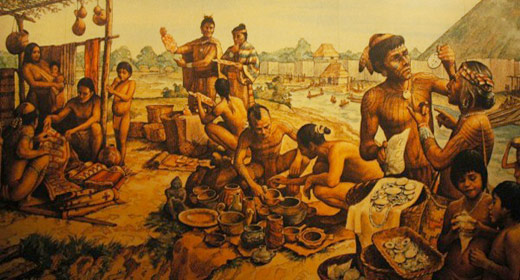by Ralph Metzner: Increasing numbers of European and African scholars are questioning the received so-called “history”
of the Italian navigator Columbus “discovering” America. As Garikai Chengu points out in his article on the Global Research website “One can only wonder how Columbus could have discovered American when people were watching him from America’s shores?”
According to American historian and linguist Leo Weiner, in his 2014 book Africa and the Discovery of America, Columbus himself related that Native Americans had told him about “black-skinned people (who) had come from the south-east in boats, trading in gold-tipped spears.” European-trained academic historians have for centuries maintained that Africans did not have the navigational skills or ship-building capabilities to cross the Atlantic, although the Greek historian Herodotus wrote of the ancient Egyptians’ great sea-faring and navigational skills. As Chengu notes, historians are beginning to move beyond the racial-intellectual prejudice of accounts of the “European age of exploration.”
In his 1976 book, They Came Before Columbus, Gyanese historian Ian Van Sertima assembled an astounding array of evidence for ancient contacts and explorations from Africa to the Americans. Extensive westward African explorations occurred when Abu Bakari II was a Ruler of the Mali empire, which dominated West Africa from the 13th to the 15th centuries. In the 14th century the Arabic scholar Al Umari wrote about the reign of the Malian emperor Musa I and his historic pilgrimage to Mecca. While in Egypt, Musa explained that he had inherited the throne after the abdication of the previous ruler. He explained that in 1310, the emperor Abu Bakari financed the building of 200 vessels of men and another 200 of supplies to explore “the limits of the sea” that served as the empire’s western frontier.
The mission was inconclusive, and the only information available on its fate came from a single boat whose captain refused to follow the other ships once they reached a “river in the sea” and a whirlpool. According to Musa I, his predecessor was undeterred and launched another fleet with himself as head of the expedition. In 1311, Abu Bakari temporarily ceded power to Musa, then serving as vizier and departed with a thousand vessels of men and a like number of supplies. After the emperor failed to return, Musa I became emperor (information compiled from Wikipedia links).
Perhaps the most convincing evidence for an early African presence in the Americas are the colossal (20 ton) Olmec stone heads found in central Mexico, displaying unmistakably Negroid features, quite unlike any other Mesoamerican depictions of faces. The Olmec civilization is the oldest of the Meso-American cultures, and is believed to have flourished around 900 BC, plus or minus 200 years. Conventional academic historians and archaeologists, who do not recognize any pre-Columbian contacts between Africa and the Americas pass over the obvious Negroid features of these sculpted heads, without comment, although, judging from their monumental size and the decorative head-dress or helmets, they clearly represent rulers or semi-divine beings, as well as demonstrating highly advanced methods of moving and working with stone. A Russian-Israeli historian of ancient Near-Eastern cultures, Zachariah Sitchin, believes that “the African Olmecs accompanied Thoth (alias Quetzlacoatl = ‘The Winged Serpent’) when Ra chased him out of Egypt, circa 3100 B.C. The Olmecs faded out of the Mesoamerican scene with the rise of the Mayas, circa 500 B.C.”(The Earth Chronicles Handbook, p. 164).
Provocative additional evidence for ancient contacts between Egypt and the Americas has recently come to light – which has sent scholars into veritable paroxysms of denial. In 1992, Dr. Svetlana Balabanova, a respected pathologist associated with the University of Ulm in Germany, analyzed samples of hair, bone and soft tissue from Egyptian mummies in the museum. She tested the samples using radioimmunoassay and gas chromatography – found no traces of opium and or lotus – but significant traces of nicotine and cocaine. Since then, Balabanova and other researchers have found nicotine and cocaine in hundreds of mummies, ranging from 800 to 3000 years of age. Now, nicotine and cocaine are only found in the tobacco and coca plants, respectively, and these are both New World plants, generally considered unknown elsewhere until after Columbus. Some scholars have pointed out that there are no representations of coca leaf or tobacco use in Egyptian paintings, though beer and opium are depicted in tomb paintings of the desired after-life. The levels of nicotine and cocaine found in the Egyptian mummies matches well with the levels found in South American mummies (Yahoo.com/question/index: Did scientists find nicotine and coca in Egyptian mummies?)
While these findings are totally in accord with the evidence of pre-Columbian trans-Atlantic trade and contacts dating to several centuries BC, current orthodox ancient history and Egyptology can’t “stomach it,” so to speak. The Yahoo expert, at the end of the article cited above, comments “Beyond the pathology results, there is little to support the idea of Egyptian trade with the New World. The Egyptians were, according to Teeter, ‘famously bad sailors’… They were incapable of crossing the Mediterranean, far less the Atlantic.” Dr. Balabanova, to her credit, does not indulge in this kind of unscientific prejudicial thinking… but simply describes her findings.









































